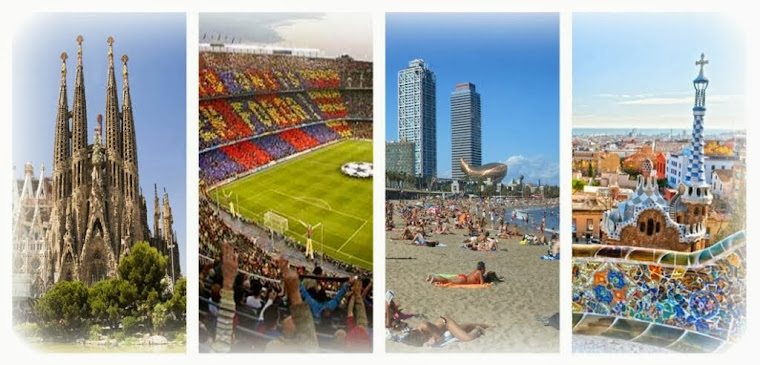When planning your trip to Barcelona, it’s impossible to ignore Gaudí’s masterpiece – the Basilica of the Sagrada Familia (‘Holy Family’). Once you are in Barcelona, the Sagrada Família can be seen everywhere, from postcards and guide books to snow globes in souvenir shops, and it’s a monument that all Catalans are proud of. This Basilica is no hidden secret, but rather an imperative for anyone visiting the city.
We would like to give you an idea of its history and architecture, as well as offering you some practical advice for visiting the church. At the bottom of the article, you will find some important information such as opening times, and the official website.
History
Although the Sagrada Familia is recognised as Antonio Gaudi’s masterpiece, he wasn’t the person responsible for placing the first stone, on 19 March 1882. This responsibility fell to the architect Francisco de Paula del Villar y Lozano, who was planning a smaller church than the one that was eventually constructed. Once sufficient funding for its construction was collected, work began in 1882 under Villar’s supervision. Very shortly, a disagreement arose with donators, and responsibility for construction was passed over to Antoni Gaudí, who at that time was 31 years old.
The original idea was that the church, dedicated to the Holy Family, would be entirely financed by donations. When Gaudí received a large donation from an anonymous source, he decided to transform the old neo-Gothic project into something more monumental and innovative as far as its shape and structure.
In 1914 Gaudí decided to dedicate himself exclusively to the Sagrada Familia project, even installing small living-quarters within the building, so that he was always on hand. Tragically, on 7 June 1926, on his way to the building, he was run over by a tram, eventually dying three days later. All of the city dressed in mourning and the Pope agreed for Gaudí to be interred in the unfinished crypt of the Sagrada Familia.
Gaudí had planned for a construction period of 200 years for the church. However, he did not leave a complete construction blueprint, as he wanted to count on the opinion of future generations.
After his death, several different architects continued work on the monument. Since that time, construction work has never been suspended, even during the difficult times of the Civil War when plaster models to scale, drawings and plans of the building were lost and destroyed.
Design
The Sagrada Familia comprises five main naves and three transverses, forming a Latinate cross. The five main naves have a total length of 90 meters and the transverses of 60 metres. When construction finishes, there will be 18 towers with a height of between 90 and 170 metres – the latter being the highest tower on a church in the world. These towers are dedicated to the apostles, the evangelists, Mary and Jesus Christ.
The three entrances symbolise the three virtues: Faith, Hope and Love, and are symbolic of the lifetime of Christ. The Nativity Façade is dedicated to his birth, the Glory façade is dedicated to his glory period and the Passion façade is symbolic of his suffering.
During the later years of his life, Gaudí planned many areas of the building so that they could be built by other people in the future. He did so by combining geometrical forms, chosen for their formal, structural, luminous, acoustic and constructive qualities: hyperboloids, paraboloids, helicoids, conoids and ellipsoids – surfaces which are ruled, making construction easier.
Visits
Of course, you don’t need to wait until 2025 to visit this impressive building. I would recommend that you visit it as early in the morning as possible. The best bet is at 9 o’clock, when doors open, as queues tend to form very early.
The first thing you will see in the interior of the church is the huge scaffolding. This makes it difficult to take in the building full dimensions. You can also use an audio-guide, which, for €4 extra, will allow you to see many other details.
Upon looking upwards, you feel very small. The enormous pillars rise up like trees up to the rafters. These impressions are doubtlessly caused by the trunk like structures branching upwards towards the ceiling. This lends a very pleasant feeling of being enveloped in warm light when the sun shines through the stained-glass windows.
You can also visit the tower for a small extra cost of €4.50, which is definitely worth it. A lift will take you to the top as going up by foot is prohibited but you are however allowed to go down by taking the stairs.
Tips
We would strongly recommend buying your ticket in advance, unless you happen to enjoy spending hours queueing! You can do this at the ticket office there or even better, book online.
If you haven’t booked in advance, make sure you arrive as early as you can, as early as 9am would be advisable on weekends to beat the crowds.
Invest in an audio guide to get the most out of your visit and hear lots of little details. They are available in Catalan, Spanish, English, French, Italian, German, Portuguese, Russian, and Chinese.
Visit the museum before you leave, located in the basement on the Passion façade. There’s a whole host of exhibitions – including photos from all stages of its construction, original designs and sketches, models of the church and information regarding the architects and craftsmen, past and present.
Address
Temple Expiatori de la Sagrada Familia (Expiatory Church of the Holy Family)
C. Mallorca, 401
08013 Barcelona
(The entrance is on the Passion Façade – Sardenya Street.)
Website: http://www.sagradafamilia.cat (in Spanish and English)
How to get here
Metro: L2 or L5 Sagrada Familia
Opening times:
From October to March: from 09.00 to 18.00
From April to September: from 09.00 to 20.00
25th and 26th December, 1st and 6th December: from 09.00 to14.00














































